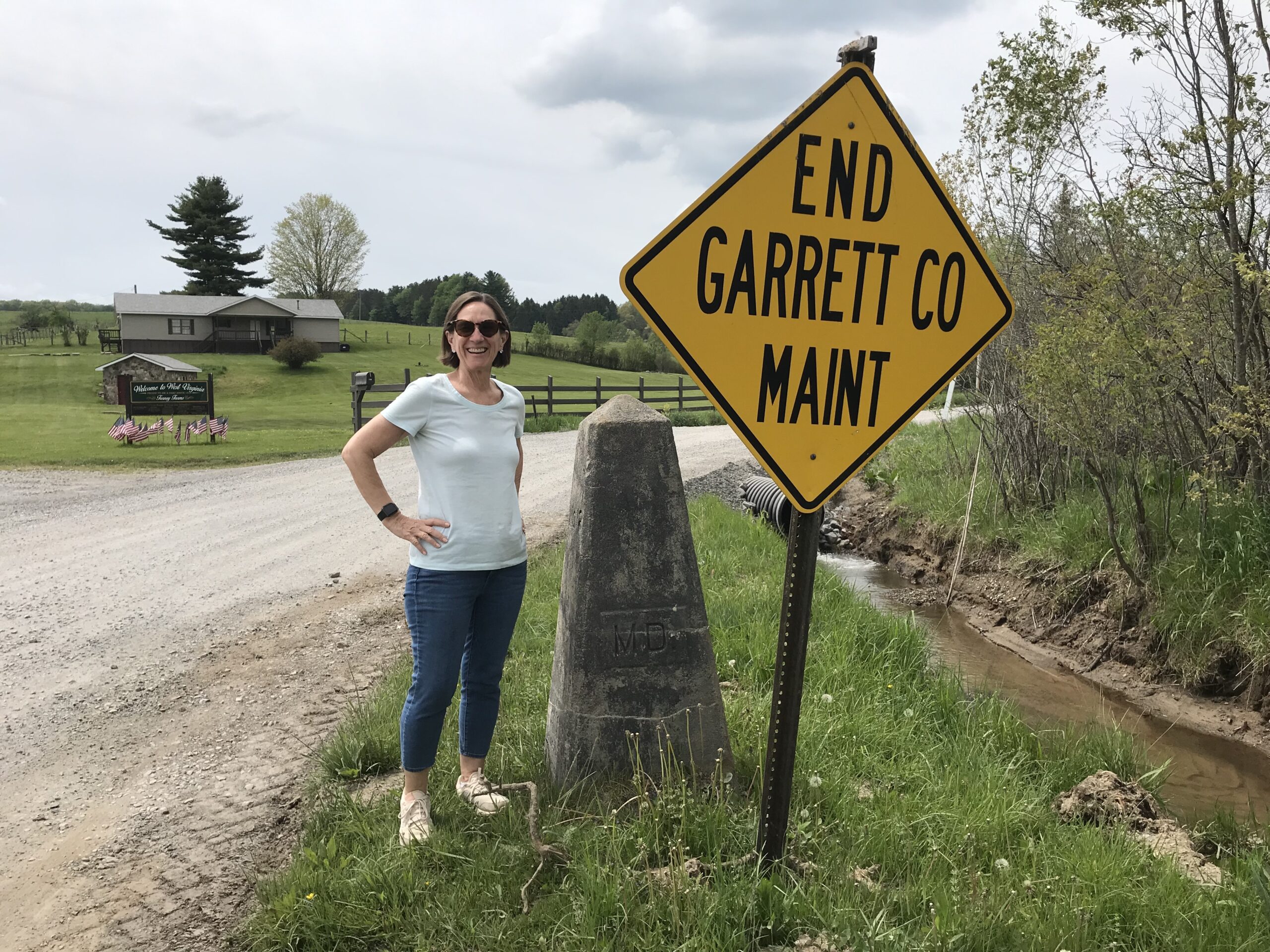Twelve counties down on Diane and Jeff Caslow’s twenty-three counties and Baltimore City day trip explorations. They are halfway through their second round of visiting every county in Maryland – a full year of adventures! Exploring from the lens of landscape preservation – walking trails, conservancies, preserves, and old railroad lines converted into trails has given a new perspective from which to enjoy each county. Garrett County has 76,000 acres of parks and they were determined to see as much of the county as they could. This is one county that takes 2 ½ hours just to get there before starting to explore so the pair did stay overnight. Take it away, Diane…
Grantsville
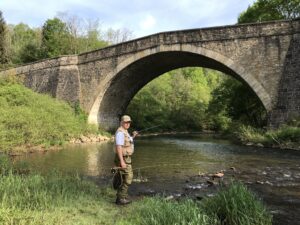 Jeff brought his fly-fishing gear along as I promised him some time to cast in the Casselman River under the historic bridge. When the bridge was erected in 1813, it was the longest single-span stone arch bridge in the United States and a link to the National Road from 1813 to 1933. Now it is a picturesque stone bridge from which Jeff pulls on his waders and fishing gear and steps into the water to enjoy nature and landscape preservation from a different perspective. Lucky for me across the bridge is the Spruce Artisan Village, an arts and heritage center. “The Artisan Village fronts on the historic National Road, which played a large role in westward expansion and economic development of the region. Little Crossings, which is what the area was originally know as, still boasts an original inn dating back to 1818 –now Penn Alps Restaurant, the historic Casselman Bridge, and thirteen restored cabins now housing resident artists. The village’s mission is to preserve the heritage of the region, which includes the Amish and Mennonite communities.” I enjoyed watching vendors setting up as part of the Grantsville National Road Festival and Yard Sale. Jeff emerged from the river with a good fish story about a rainbow trout “catch and release.” We explored the artists and craftsmen in the restored log cabins, chatted with some of the vendors and made some purchases from Stella’s Dot and a local beekeeper. Driving down the national road through Grantsville we saw a lot of the town out for the yard sale. We stopped at High County Market and Creamery for some cheeses and grabbed dill cheese curds to munch on the way.
Jeff brought his fly-fishing gear along as I promised him some time to cast in the Casselman River under the historic bridge. When the bridge was erected in 1813, it was the longest single-span stone arch bridge in the United States and a link to the National Road from 1813 to 1933. Now it is a picturesque stone bridge from which Jeff pulls on his waders and fishing gear and steps into the water to enjoy nature and landscape preservation from a different perspective. Lucky for me across the bridge is the Spruce Artisan Village, an arts and heritage center. “The Artisan Village fronts on the historic National Road, which played a large role in westward expansion and economic development of the region. Little Crossings, which is what the area was originally know as, still boasts an original inn dating back to 1818 –now Penn Alps Restaurant, the historic Casselman Bridge, and thirteen restored cabins now housing resident artists. The village’s mission is to preserve the heritage of the region, which includes the Amish and Mennonite communities.” I enjoyed watching vendors setting up as part of the Grantsville National Road Festival and Yard Sale. Jeff emerged from the river with a good fish story about a rainbow trout “catch and release.” We explored the artists and craftsmen in the restored log cabins, chatted with some of the vendors and made some purchases from Stella’s Dot and a local beekeeper. Driving down the national road through Grantsville we saw a lot of the town out for the yard sale. We stopped at High County Market and Creamery for some cheeses and grabbed dill cheese curds to munch on the way.
Friendsville


The Kendall Trail in Friendsville is part of the Rails to Trails Conservancy. It follows the Youghiogheny River along the Confluence and Oakland railroad, an abandoned railroad bed to a former logging town of Kendall. The trail parallels the river which is a Shawnee name for “river that flows in a contrary direction.” The peaceful river view, rock formations and banks of huge old rhododendron bushes that line parts of the trail made it one of the prettiest rails to trails we have walked. Although we did not make it all the way to Kendall, we tried to image a century ago when the rail cars were full of lumber during the week and picnickers on Sundays. Before we left this northeastern part of the state, we headed to Deep Creek Cellars to pick up some wine. When we called ahead to order, the owners said come on by for a drive-thru tasting. What a novel way to taste wine, overlooking the beautiful hills and farmland and talk to the owners about their history of winemaking in Maryland. Of course, we did buy a few bottles of wine for later.
Cranesville Swamp Preserve
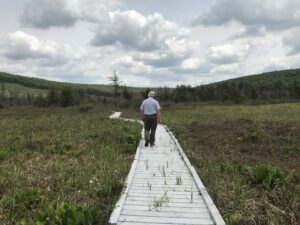 We followed the border south between West Virginia and Maryland until we found the Cranesville Swamp Preserve. It is a 1,600-acre preserve purchased by the Nature Conservancy in 1960. “It is one of the few remaining boreal bogs in the southern United States, unusual in harboring many plants and animals that are normally only seen in more northern climates. It was designated as one of the first National Natural Landmarks in the country in 1964.” The bog has a mind of its own as it was creeping across the walkway and up from underneath the slats of the boardwalk. Jeff gently put his foot on what looked like moss but felt like a sponge. It was worth going off the beaten path to visit.
We followed the border south between West Virginia and Maryland until we found the Cranesville Swamp Preserve. It is a 1,600-acre preserve purchased by the Nature Conservancy in 1960. “It is one of the few remaining boreal bogs in the southern United States, unusual in harboring many plants and animals that are normally only seen in more northern climates. It was designated as one of the first National Natural Landmarks in the country in 1964.” The bog has a mind of its own as it was creeping across the walkway and up from underneath the slats of the boardwalk. Jeff gently put his foot on what looked like moss but felt like a sponge. It was worth going off the beaten path to visit.
Oakland
Our first stop near Oakland was to return to Mountain Lake Park (see our first visit to Garrett for a full description of the area). We headed to Simon Pearce, a high-quality glass factory and showroom that is housed in a previous Bausch & Lomb factory. During our last visit we were able to watch one of the glass blowers at work. Hard to choose just one thing to purchase. The Oakland Historic District includes the 1884 B&O railroad station as well as buildings that have been repurposed into restaurants and stores. A late lunch at The Vagabond Taproom gave us a chance to enjoy a spring afternoon and listen to live music. A walking path along the little Youghiogheny River on the western edge of Oakland took us to the Washington Spring. It is said that George Washington stopped at the spring in 1784. When the Oakland Hotel was built by the B&O Railroad in 1875, a walking path was laid down so the guests could follow the path and “duplicate George Washington’s act of taking a refreshing drink of water from the spring.” Instead of duplicating George Washington, we opted for homemade ice cream at Devlers Ice Cream to wrap up our day.
Deep Creek
“Deep Creek Lake is Maryland’s largest freshwater lake, covering 3,900 acres and 65 miles of shoreline. The man-made lake got its start in 1925 as the result of an effort undertaken by the Youghiogheny Hydro Electric Corporation to harness the power of Deep Creek, a tributary of the Youghiogheny River.” We stayed overnight at the Lodges at Sunset Village, in one of several cabins that sit on a hill overlooking the lake. A local grocery store provided just what we needed to watch the sun setting over the lake and mountains – bread and baked goods from the local Mountain Flour Baking Company, along with fruits and nuts to pair with the High Country Market and Creamery cheeses.
Savage River State Forest
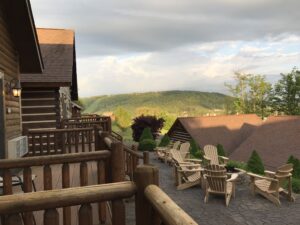 Up early and watching the sunrise on our little deck was a good reminder to just sit and enjoy the view every once in a while. Jeff had one more opportunity for a little fly fishing along the Savage River. At the Savage River Fly Outfitters the owner, not only gave Jeff some fishing guidance, but showed off some of the hand-tied Cicada lures. As I dropped him upstream at the Garrett Bridge, I reminded him that there was no cell service near the bridge, so be careful not to get swept down river. He complied and an hour later I picked him up with a smile on his face. It is hard to describe how beautiful the forests are in the county. Instead of our planned hike, we simply drove the winding roads through the forest, appreciating what it is today. “By the early 1900s, narrow gauge railroads were used to facilitate logging on steeper slopes as the demand for wood products continued to increase. The result was that Garrett County was heavily cut-over, essentially clear cut, within a 20-year period. The train engines frequently caused forest fires in the tops and slash that were left from the clear-cutting. As a result of the fires, a new forest was created. This legacy we can see today as most of our older forests are the same age and are approximately 100 years old. In part, as a reaction to the rapid cutting of trees and the burning that was taking place, the Garrett Brothers, in 1906 gave 2,000 acres to the state with the proviso that an agency would be created to manage the property and to institute scientific forestry- this led to the birth of the Maryland Forest Service. The rapid exploitation of the forests came to an end by the 1930s and logging companies moved west or converted to coal mining. The early efforts of the MD Forest Service were primarily fire suppression. In 1929, the state purchased 9,352 acres of cut-over forest land from the N.U. Bond Company. This was the beginning of Savage River State Forest. Since that time there has been several acquisitions both big and small. Now Savage River State Forest consists of 54,324 acres. In the 1930s, the Civilian Conservation Corps assisted the forest service with fire suppression efforts, tree planting, and constructing facilities for recreational activities. They helped build many trails where hiking, biking, horseback riding, and off-road ORV riding are still taking place.”
Up early and watching the sunrise on our little deck was a good reminder to just sit and enjoy the view every once in a while. Jeff had one more opportunity for a little fly fishing along the Savage River. At the Savage River Fly Outfitters the owner, not only gave Jeff some fishing guidance, but showed off some of the hand-tied Cicada lures. As I dropped him upstream at the Garrett Bridge, I reminded him that there was no cell service near the bridge, so be careful not to get swept down river. He complied and an hour later I picked him up with a smile on his face. It is hard to describe how beautiful the forests are in the county. Instead of our planned hike, we simply drove the winding roads through the forest, appreciating what it is today. “By the early 1900s, narrow gauge railroads were used to facilitate logging on steeper slopes as the demand for wood products continued to increase. The result was that Garrett County was heavily cut-over, essentially clear cut, within a 20-year period. The train engines frequently caused forest fires in the tops and slash that were left from the clear-cutting. As a result of the fires, a new forest was created. This legacy we can see today as most of our older forests are the same age and are approximately 100 years old. In part, as a reaction to the rapid cutting of trees and the burning that was taking place, the Garrett Brothers, in 1906 gave 2,000 acres to the state with the proviso that an agency would be created to manage the property and to institute scientific forestry- this led to the birth of the Maryland Forest Service. The rapid exploitation of the forests came to an end by the 1930s and logging companies moved west or converted to coal mining. The early efforts of the MD Forest Service were primarily fire suppression. In 1929, the state purchased 9,352 acres of cut-over forest land from the N.U. Bond Company. This was the beginning of Savage River State Forest. Since that time there has been several acquisitions both big and small. Now Savage River State Forest consists of 54,324 acres. In the 1930s, the Civilian Conservation Corps assisted the forest service with fire suppression efforts, tree planting, and constructing facilities for recreational activities. They helped build many trails where hiking, biking, horseback riding, and off-road ORV riding are still taking place.”
Grantsville (again)
We came full circle and had brunch at the Cornucopia Café in the Spruce Artisan Village. One last stop for some purchases at the Little Crossings Pantry and then headed home.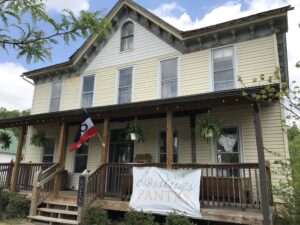
It continues to surprise us that we continue to find much more to discover across Maryland. On to the next half of the adventure……

